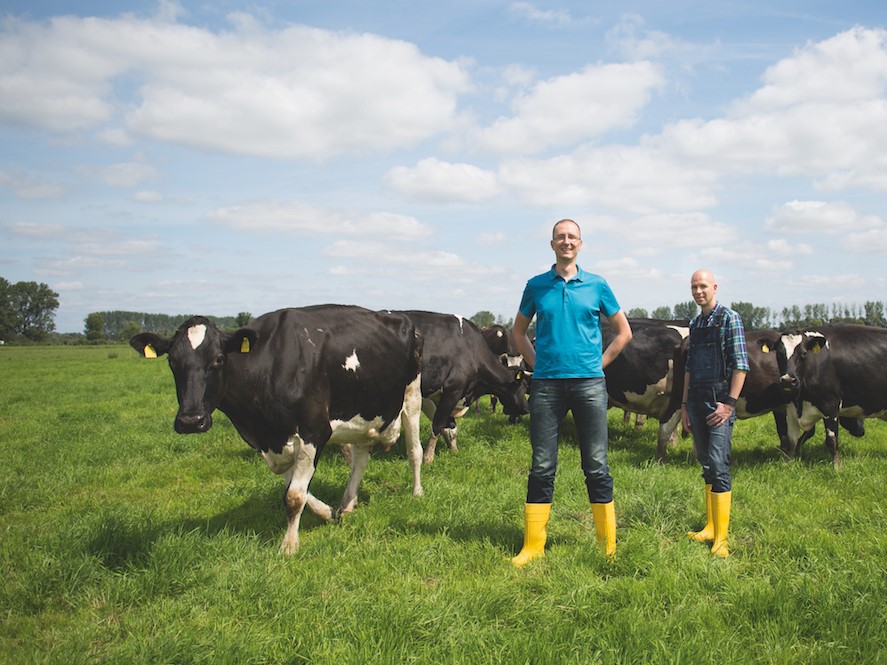dropnostix - Digital solutions for agriculture

Healthy cows mean happy farmers. After all, only healthy cows produce milk that is good enough to run a farm successfully. But it takes a lot of work to keep cows healthy. A company in Potsdam has now developed a system that takes some of the hassle out of farming, making everyone in the cowshed happy.
A small box of coloured lozenges stands on Lars Abraham’s desk. The managing director of dropnostix GmbH from Potsdam explains that he takes one of these packs with him to every meeting with farmers and to trade fairs. Mr Abraham picks up a coloured drop, holds it up in the air and says: “If you swallow this, it’s basically the same as giving a cow a bolus sensor.”
A cow monitoring system in real time
The bolus sensor is a measuring device in the stomach (rumen) of a cow. This ten-centimetre-long cylindrical device is so small in relation to the size of the cow’s stomach that is does not cause any discomfort. Very much like a lozenge in a person’s stomach. The sensor provides farmers with valuable information about their cows’ health. The transmitter continuously analyses how the animals are doing in the cowshed: their body temperature, how much they move, whether they stand or lie down, eat and drink enough, whether they are ready to mate and how births develop. But there is one very essential question behind all this: Is the cow healthy? Only then will the cow produce good milk.
Sensors from all the cows’ stomachs transmit digital data to the dropnostix control centre in Potsdam via a receiver transmitter located in the cowshed. The sensor reports any abnormalities at an early stage. Experts at dropnostix then compile all the data, evaluate it and send the most important information to the farmers by e-mail or as a text message. The farmers can then see in real time whether they need to take measures to improve cow welfare, for instance, medical treatment, and which animals need to be seen to. “Staff in the cowshed are no longer able to do this extra work, which goes beyond routine jobs like milking and feeding,” explains Lars Abraham. Due to the tightly scheduled production, there is simply not enough time for this. In a cowshed with 40 cows, staff would have to individually observe and examine all the cows that have just calved every single day, as well as providing individual care and treatment as needed. The solution is to simplify time-consuming cow observation.
Tomorrow’s smart cowshed
Business graduate Lars Abraham and biochemist Michael Breitenstein founded their start-up in Potsdam in 2015 and then went on to develop the product of the same name in the years that followed. The development of the receiver system for the cowshed and of a measurement sensor prototype as well as the establishment of cloud server solutions and databases are among the projects that were co-financed by the European Regional Development Fund (ERDF). dropnostix is also receiving further ERDF funding from the Early Stage and Growth Fund.
For further information, visit www.dropnostix.com
A small box of coloured lozenges stands on Lars Abraham’s desk. The managing director of dropnostix GmbH from Potsdam explains that he takes one of these packs with him to every meeting with farmers and to trade fairs. Mr Abraham picks up a coloured drop, holds it up in the air and says: “If you swallow this, it’s basically the same as giving a cow a bolus sensor.”
A cow monitoring system in real time
The bolus sensor is a measuring device in the stomach (rumen) of a cow. This ten-centimetre-long cylindrical device is so small in relation to the size of the cow’s stomach that is does not cause any discomfort. Very much like a lozenge in a person’s stomach. The sensor provides farmers with valuable information about their cows’ health. The transmitter continuously analyses how the animals are doing in the cowshed: their body temperature, how much they move, whether they stand or lie down, eat and drink enough, whether they are ready to mate and how births develop. But there is one very essential question behind all this: Is the cow healthy? Only then will the cow produce good milk.
Sensors from all the cows’ stomachs transmit digital data to the dropnostix control centre in Potsdam via a receiver transmitter located in the cowshed. The sensor reports any abnormalities at an early stage. Experts at dropnostix then compile all the data, evaluate it and send the most important information to the farmers by e-mail or as a text message. The farmers can then see in real time whether they need to take measures to improve cow welfare, for instance, medical treatment, and which animals need to be seen to. “Staff in the cowshed are no longer able to do this extra work, which goes beyond routine jobs like milking and feeding,” explains Lars Abraham. Due to the tightly scheduled production, there is simply not enough time for this. In a cowshed with 40 cows, staff would have to individually observe and examine all the cows that have just calved every single day, as well as providing individual care and treatment as needed. The solution is to simplify time-consuming cow observation.
Tomorrow’s smart cowshed
Business graduate Lars Abraham and biochemist Michael Breitenstein founded their start-up in Potsdam in 2015 and then went on to develop the product of the same name in the years that followed. The development of the receiver system for the cowshed and of a measurement sensor prototype as well as the establishment of cloud server solutions and databases are among the projects that were co-financed by the European Regional Development Fund (ERDF). dropnostix is also receiving further ERDF funding from the Early Stage and Growth Fund.
For further information, visit www.dropnostix.com

